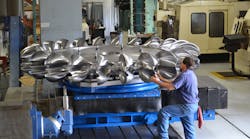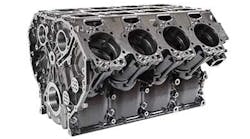Making large holes in ferrous metals can bepretty slow going. Big twist drills take a lot of power, and can be expensive and hard-to-find in odd sizes. Flame cutting will work only if the material is flat plate, plus it is a cumbersome process and leaves a lot of finishing work to be done. Trepanning, involving expensive, dedicated tools, is limited to repetitive, high-volume work. Orbital milling is faster and more versatile, but there is always the risk of snapping off the brittle solid-carbide end mills.
Recently, Baldor Electric Co.’s Gainesville, Ga. plant improved the large hole-making process for one part so successfully that it adapted the approach for 10 other jobs at there — and its now being considering for jobs at several other Baldor Electric plants.
Baldor manufactures electric motors and adjustable speed drives, and the Gainesville operation has 400 employees producing AC and DC motors (1-1,500 HP).
By switching from orbital milling to corkscrew milling with an indexable, Ingersoll Cutting ToolsHi-Feed Deka face mill for holes over 1.500 inches, Baldor has cut the process cycle time by an average of three to one, and improved tool life by 10 to one. Then, a boring sequence finishes the holes, as before. The annualized saving from the process change at Baldor Gainesville is estimated at more than $40,000 annually.
The switch got its start early in 2010 when Darimus Glasper, manufacturing engineering technician at Gainesville, started looking around for a faster way to open three-inch holes in a ductile iron casting with two-inch thick walls. The part is an explosion-proof cover that encloses the electrical leads in large motors. Baldor Gainesville’s annual production volume is 100 of these pieces, performed intermittently in 10-piece lots.
“Because of the workpiece geometry, the holes must be drilled from solid in a long-reach setup,” Glasper said. “Not only was it slow going with the orbiting method and the solid-carbide too: we also went through a lot of tools.” Moreover, he recalled that operators were concerned because the spindle load meter read 90% even at that slow rate.
At the time, Baldor’s standard approach to roughing out the holes was orbital milling with a 3/4-inch, four-flute solid carbide end mill. In orbital milling, the technique is to plunge about 0.100 inch and then orbit the tool at a very careful feedrate (so it will not snap off, as brittle solid carbide end mills are likely to do.) Then, the process is repeated until there is a break through, with the hope that the resulting slug doesn’t pose a safety hazard or damage the tool. It’s basically start-and-stop. For each hole that Baldor machinists produced in the two-inch thick walls, they had to follow about 20 steps.
Glasper chose the explosion proof cover as a starting point in the search for productivity improvements because, as one of higher-volume items requiring large holes, Baldor would readily recognize the savings because of it cost. “Solve it on the highest-volume part, and we get the biggest immediate payback,” he explained.
Looking for new ideas
For ideas he asked Ingersoll’s Chris Pope, who suggested the corkscrew technique using a larger-diameter indexable mill with high feed inserts. “In corkscrew milling, the cutter advances continuously as it orbits,” Pope explained. “And, the high-feed insert geometry means you can advance faster with shallower cuts, getting through the material faster while reducing cutting forces and spindle loads.”
The corkscrew milling technique has been established for some time, but until recently its practical applications were limited. In corkscrew milling, the toolpath is helical and continuous, not stepped, as in orbital milling. The principal applications included already-opened holes and thin materials, and horizontal setups where gravity took care of chip clearance.
The idea of plunging vertically into thick solid metal requires a leap of faith. In another Georgia operation, a small job shop, the owner saw a demo of the process on guide pin holes in wrought tool steel die sets. He bought the tool on the spot and jotted down the field engineer’s recommended parameters. Then, he ran it in scrap wood for weeks and weeks before working up enough courage to run it on a real workpiece. Once he finally got running, hole-making time dropped by eight to one.
In Chris Pope’s first trial run at Baldor, a three-flute Hi-Feed Dekamill running in the corkscrew mode completed each hole in five minutes, as opposed to a 17-minute cycle recorded for a comparable job with the orbiting method. For the trial, the cutter advanced helically 0.031-inch per “orbit,” opening the hole in six revolutions, and it orbited at 214 IPM versus 12 IPM for orbital milling. Surface speed was 800 SFPM, versus 335 SFPM.
The demo was so convincing that Glasper standardized on the corkscrew process within two weeks. “I’d never seen a hole roughed out from solid that fast in my life,” he said.
Re-engineering the process was not a simple drop-in tool replacement. It involved reprogramming toolpaths and machine parameters as well as re-plumbing the machine to provide through-spindle flood coolant for chip clearance. Pope and Ingersoll southeast manager Phillip Johnson assisted with the parameter setting.
The change paid off immediately, however. The cycle time to rough out each hole in the cover dropped from 17 minutes to five minutes, exactly as in the test, and edge life improved by 10 to 1. The previous solid -carbide roughing cutter lasted through just one hole, while a set of edges on the indexable cutter lasts through ten. “The new method is not only much faster, it also involves much less maintenance,” according to Glasper.
Here’s the math: Each insert has ten edges, yielding about 100 pieces apiece. A new set of three inserts, good for the next 100 pieces, costs much less than a single solid-carbide mill that goes dull after only one.
Completely different method, tool
The production gains achieved at Baldor Gainesville stem from a total method change based on completely different tool designs, according to Ingersoll’s milling product manager Mike Dieken. “First, the cut is continuous down the helical toolpath, not start-and-stop,” he began.
“Second, the indexable tool has twice the diameter as the solid-carbide mill and it has a steel cutter body,” he continued. “This makes it much better able to withstand the lateral forces involved inherent in the process at those high MRRs. Moreover, the 70-degree lead angle helps mitigate the impact and lateral forces at entry.”
He added that the combination of high-feed insert geometry and fewer flutes achieves much higher chip loads. “The 1.5-inch indexable Hi-Feed Deka face mill can withstand feed rates of 0.015- 0.040 inches per tooth, versus 0.002-0.006 for a 3/4-inch solid carbide mill, Dieken continues. “And, with fewer flutes, there is more room for the chips that come off so much faster.”
The change also removed a wild card, added Chris Pope. “Because most holes at Gainesville measure less than three inches and the 1.5-inch tool covers more than half the diameter, there is no slug to upset things. All the metal exits as chips.” (Since he led the process change at the Gainesville plant, Pope has joined Gamco Services, Inc. Baldor’s principal integrated supplier.)
Over the following several months, as orders came in, Glasper applied the same corkscrew million process to other, smaller-volume workpieces. Today, Baldor-Gainesville uses the method on several different jobs that require holes of 1.500 inches, and larger. Many of these projects involve odd diameters, for which standard twist drills are hard to find.
Soon after the successful trial, Glasper and commodity manager Doug Bushey shared their experience via one of the weekly idea-sharing conference calls that Baldor conducts with all of its plants. As a result, ten other Baldor plants now are in various implementation stages with the corkscrew milling method.
“The process is tough to believe,” concluded Glasper, “but the results speak for themselves.”








